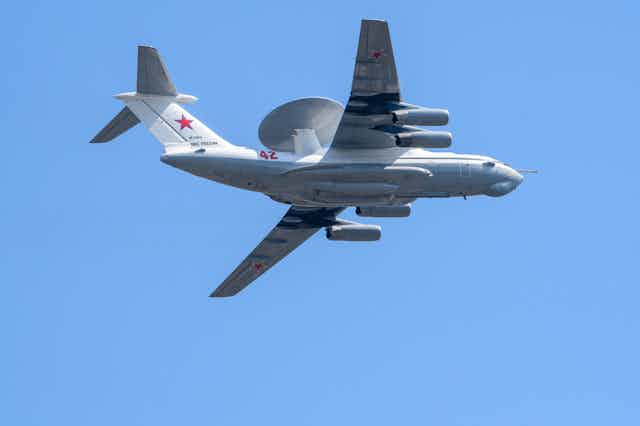In recent days, the Ukrainian military claims to have destroyed or irretrievably damaged two Russian aircraft over the contested ground of Zaporizhzhia oblast. The role of these aircraft is to provide the Russian military – particularly its ground force – with certain capabilities. These include the ability to coordinate air and ground forces, observe and track targets of opportunities and provide real-time aerial intelligence.
Russia’s ability to perform these functions has now been significantly degraded. While the loss of individual aircraft will not have a decisive effect on Russian capabilities in the long term, it will make the application of air power and the ability to conduct operations on the ground, both offensive and defensive, more difficult in the short term.
The good news for Russia’s military is that it is winter, so things are fairly static on the ground at the moment because of the harsh weather. But this may be outweighed by other considerations. Most importantly, Russia is understood to have a limited stock of these aircraft types – and the Russian industrial base has a limited capacity to replace them.
Expensive and hard to replace
The Beriev A-50 is an airborne early-warning and control aircraft that first entered service in 1985. Its primary function is to track up to 300 targets simultaneously within a range of 180 miles using its onboard radar systems. These can be on land, or at sea or in the air.
Despite being in service for almost 40 years, the A-50’s age would not be a major concern for the Russian air force. The roles that this aircraft plays do not require it to have the latest cutting-edge technology in terms of speed or range, particularly given the areas in which it is operating.
The one weakness that this and almost all aircraft of this type have is that in hostile airspace they are vulnerable to air and ground-based defensive fire. This is despite their defensive capabilities, such as electronic countermeasures which are supposed to protect them from guided enemy missiles.
So deployment has to be considered carefully. It appears from open-source intelligence that the A-50 has been increasingly deployed to try to counter the increased risk to Russian military infrastructure in Crimea from Ukrainian air attack.
The sheer cost of the A-50, estimated at US$330 million (£260 million) per aircraft, will be a blow to Russian military planners. But a bigger worry by far will be the loss of a highly specialised crew that take many years to train. This is not a capability that can be easily and quickly replaced.
The Ilyushin Il-22, meanwhile, is an airborne command post that is used in the command and control and radio relay roles. These are two vital roles in warfare as the ability to coordinate forces in both an offensive and defensive capacity ensures that operations are conducted effectively and efficiently. This ensures that commanders are able to direct their forces in line with operational and strategic objectives.
Initial reports suggest that this aircraft was badly damaged but was able to return to a Russian air base. There have also been claims that the damage is so serious the aircraft cannot be repaired.
Friendly fire
There is no clear evidence as to how these aircraft were targeted. Apart from its initial claim to have destroyed or damaged the aircraft, Ukraine has not commented further. Russia meanwhile, has made no official comment. A Russian milblogger has reportedly suggested the planes had been hit by friendly fire or even shot down by a team of British SAS operatives using surface-to-air missiles.

This explanation may be an attempt aim to provide the Russian air force with the opportunity to deny that these incidents were due to the effectiveness of Ukrainian air defence systems, such as the Patriot ground-based system provided from December 2022 by the US. But this, in turn, raises important questions about how well Russia has trained its forces about the recognition of friendly and hostile aircraft as well as its ability to control the airspace in which it is operating above Ukraine
If it emerges that the loss of both these aircraft was due to Ukrainian action, it will bolster the confidence of their ground forces to engage and destroy these targets. It would also provide greater evidence for senior military and political leaders for the continued supply of these weapons systems.
How the aircraft were lost is almost an irrelevance. Both nations will put out their version of events as a continuation of the propaganda war that is assuming more and more importance in 21st-century conflict, particularly with the rise of social media platforms.
The loss of the A-50 and Il-22 are significant blows to Russian military capabilities in Ukraine. This is not down to the lack of numbers that exist within the Russian inventory, or the cost and time that will be required in replacing them.
These are obviously concerns, given the huge expense of state-of-the-art aircraft. But the loss of the highly specialised crew that take many years to train will create the largest capability gap, especially in command and control.
This will make the coordination of air and land operations near the frontlines much more complicated to plan and conduct, making them more hazardous for those who are conducting them and leading to greater confusion within the command chain.

